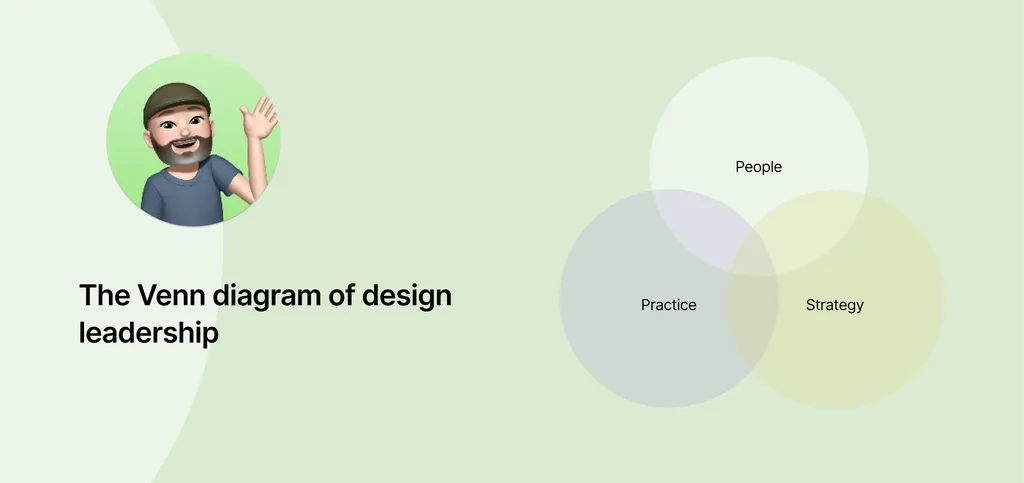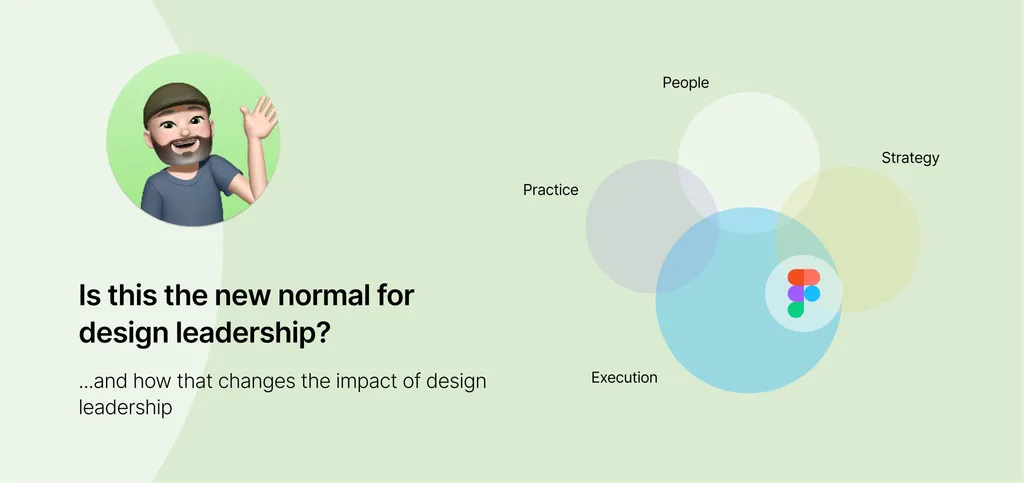The title is a play on the traditional proclamation made following the accession of a new monarch in various countries (I’m a Brit so it’s familiar to me). The seemingly contradictory phrase simultaneously announces the death of the previous monarch and asserts continuity by saluting the new monarch.

What is this about?
The need for this post came from some reflection of what I’m seeing in the industry (~July 2024), while searching for design leadership roles. Specifically how companies are advertising for Head of Design roles, and how the expectation of that level misaligns with my own mental model.
I’m also hearing soundbites in mentoring sessions, of folks reporting directly to CTO or Eng leadership and really struggling to communicate the ‘why’ behind their approach and process. When often the perception from non-design crafts is design is a blocker or that other stuff isn’t what I need right now.
So what is a Head of a Design? I’d like to outline previous and current shapes of the role (from what I’m seeing in the market in AU), to help folks understand the differences. With hope that more empathy and understanding of the multiplier benefits of design leadership can be understood and influence future hires.
Head of Design is dead…
I’ve sat with this statement for a week now, and like overcoming grief gone through the 5 stages of grief (I process quickly).
- Denial: The Protective Shield
- Anger: Channeling Frustration and Resentment
- Bargaining: Seeking a Sense of Control
- Depression: Navigating Sadness and Loss
- Acceptance: Embracing Healing and New Beginnings
While the easy path is to be offended — and I was. A more assertive path would be to brush up on news skills and to help educate our new leaders, founders, peers, and talent teams. These folks may not be aware of the ‘why’ behind staple design exercises like formative research, competitor reviews, and understanding JTBD. In an industry where delivery matters and startups are bootstrapped, communication is paramount. This is amplified when you suddenly report to someone who is not versed in design practice.
So, long story short, and approaching it from my lens, this post is an attempt to demystify the role of design leadership for non-design leaders starting and running a business.
Desired outcomes
If by reading this post you come away with more empathy of what design leadership is and see the potential to amplify what the role can do for your business, that’s a huge win.
So what is traditional design leadership (and as a non-designer why should I care)?

Let’s ask Ai:
Investing in design leadership can significantly benefit organizations by fostering a culture of innovation, enhancing team performance, and improving customer satisfaction. It involves integrating design thinking into leadership practices, promoting diversity, and focusing on human-centered leadership. This approach can lead to more creative, inclusive, and effective design solutions, ultimately contributing to the organization’s success.
While someone on the tools shipping valuable product is important, I’d argue that’s what the team is for. Design leadership is about shaping a practice and culture around innovation. That innovation culture is what sets you apart from the competitors and helps you uncover the unknowns that make your scaling business a rocket ship.
Design leaders act as multipliers of a team and improve performance. That is often done through influence with leadership peers (CTO, Founder, CPO) in exploring ways of working or changing to strategic focus. Hiring diverse skill sets to build more competency and difference of thought in a team. Additive outcomes are being accurate more frequently, discovering bigger opportunities than you thought possible, and hitting bigger wins. On the subtractive side, design leadership can reduce waste. All these factors improve performance.
Strategy changes from doing to facilitating in leadership roles. As peer and partner design leadership is an equal listener and soundboard, helping with integrating design thinking into leadership practices.
Design leadership benefits a leadership team in many ways. The most familiar, and my own interpretation of communicating the role, is People, Practice, and Strategy.
People
We will advise and take the lead on the team shape, skills, depth of craft, and complimentary crafts. We advise when a team needs research, content design, or specialist skills such as DesignOps or prototyping.
We know how to hire and build teams based on the business need.
We create a community for teams and support their growth as mentors and coaches. If designers are not growing with you — they will look for it elsewhere. That affects your ability to grow if you have high attrition.
In the early stages (first couple of designers) or low-maturity orgs, a design leader may be asked to drive outcomes themselves. In high-maturity orgs and those with low attrition, design leaders are able to create autonomous teams. Their remit is to create clarity on the goal, providing counsel on achieving objectives, removing impediments, and supporting the outcome. “Hands-on” is typically defined as using the wealth of their experiences to achieve outcomes, but through a team of design professionals.
Practice
Design leaders lead change. Ideally with many years of IC (Individual Contributor) and Leadership Experience. They would have first-hand experience of scaling challenges and the experience of how to approach change.
Where a team of individuals is as good as the worst hire, a team aligned to a culture and way of working is a force multiplier. Individuals working together to raise the bar for the entire group.
Many leaders have experience with DesignOps out of sheer need. More recently this is a role in itself and brings a ton of value to an organization. Until that point, a versed Design leader can influence changes in rituals and approaches to design that up-level the outcomes of the work. Therefore influencing the metrics for your business.
A leader will shape a model for how a group designs and ships products.
- How designers plan their work, and make space for what’s required.
- When, where, and how research is used. Whether it’s funded or a stretch goal for a team. Define and measure a rubric for how to expect quality outcomes.
- Feedback on the work, and direction for designers to take back to their teams.
- Engagement models with collaborating teams. What, when, and how we work together.
Strategy (or Product)
As a co-collaborator, contribution to a strategy comes as much from listening and watching for risk and assumptions as it comes from action. We bring a domain understanding of both the needs of the customer and the business and apply it to a given situation.
Design initiatives are tied to the goals of the business. A strategy may look further out than the known, and address areas that haven’t been discussed yet. An example could be the unmet needs of a customer, a use case not explored, or an impact on other workstreams or business groups.
Design, at its core, is user-centric, creative problem solving. A great design leader applies their knowledge and experience to the advantage of their organization, identifying and meeting the needs of its customers. The design leader must understand how the organization works, and have the ability to tie design initiatives to business strategy.
When leaders do this well: The company actively seeks to measure and improve the customer experience beyond short-term fixes. Designers and design leaders have a seat at the strategy table and thrive in helping to reach decisions for the business.
What are the trends I’m seeing?
So if the Head of the Design is dead in the traditional sense, what changes for their successor?

I’ve read a ton of job adverts in July and August. It seems a new shape is emerging that is different from the model of people, practice, and strategy. A layer of leadership has been consolidated.
The expectation to execute is becoming more pronounced. With many adverts referencing “60% hands-on in Figma”.
The scope and scale of the roles are small teams. The addition of the 4th circle of execution will inevitably diminish the impact of traditional scope. People, Practice, and Strategy.
More hands are required to execute. Additive, not leadership as a multiplier.
Why is this happening?
Great Question. To channel my default designer answer ‘it depends’. It depends because the answer isn’t black and white, nor is it from the lens of a single individual. This is also pure conjecture. Happy for your points of view in the comments.
Who are the individuals? It’s not confined to these players, but channeling personas and drivers of each.
Founders
Very few founders come from a design background. Those that do, have put in the hard yards with their partners or formed their own company to operate the way they want to work. Typically leading with delight and making products that delight customers. Others are either business or technical. Design practice and experiences in building innovation teams are not in their vocabulary and don’t drive their reason for being.
There may be a perception that Innovation isn’t required, or that the flows, tasks, and first designs are going to be accurate and resonate with customers. This is low maturity because of the lack of understanding.
In these environments, a plan is set out, PRD locked, and the roadmap is executed on known knowns for the near future.
Hiring Managers
Early-stage designers often report to the critical first hires. In tech, and with the need to ship something to secure further support and VC, that first hire is 95% certain to be a CTO or Engineer. Whether working alone or leading a small team, pushing shippable code to production is a sign of impact. To create more impact, we ‘need designs faster’, which equals ‘we need more designers’. Fast forward to we have ‘too many designers and need a manager’, ‘but that person needs to ship too’.
Someone needs to short-circuit and influence this loop.
Consultants
If it happens more frequently than by chance, it’s likely been designed and sold as a solution.
Designers
Let’s hold a mirror to ourselves and be open, shall we? The path to design leadership is complex, and ideally comes from years of experience as an IC, putting in the yards, learning from failures, learning to influence, and then working our way up the ladder. If we are given a chance to do that much earlier in our careers — why would we say no? It’s human nature. The problem being, it’s the designers who have made rapid gains are now hiring managers and writing job descriptions.
Eeek, that sounds like it sucks. What can we do about it?
Firstly congrats on getting this far, and thank you for your curiosity. I know that was a lot.
If in reading this post, you understand a little more about ways a design leader can positively influence innovation in your organization, that’s awesome. I hope you refer to this in the future when you plan an expansion of teams. If need be bring in a design leader to consult on strategies and plans. Ask for their point of view on how this impacts craft.
Some practical tips and advice.
In the early days or with a small team, maybe you don’t need to invest yet, or costs don’t justify it yet. That’s 100% acceptable. Hire the right person for the needs of the org. If that’s a hands-on SME in the weeds, you need a Lead. A lead will be able to drive outcomes for the product, but less likely to be able to focus on driving practice or growing people. A lead will be a 1:1 multiplier.
Recognize the value of innovation. Change starts at the top, requiring leaders to do some soul-searching. Can you afford to be wrong?
Hire multipliers. A multiplier will amplify a team’s work, influence, and outcomes. Their influence with leaders is unseen, but influence nonetheless. Design leaders have a 1:Many multiplier ratio in teams.
Recognize Figma is not the whole output of design. It’s a tiny piece of the puzzle. It’s a way to realize strategies, not define them.
Broaden skills and up-skill. Until change happens at the leadership level and design has a seat at the table once more. I’ll be learning Figma… If nothing else I can pull up a chair.
Any scaling businesses curious about growing their design leadership presence — feel free to reach out. Happy to chat about the opinions of this post and how I might be able to help.
I have affordable rates for Advisory, Fractional Leadership support, or bespoke packages in the traditional Venn diagram of Design Leadership: People, Practice, and Strategy.
The article originally appeared on Medium.
Featured image courtesy: Getty Images.








